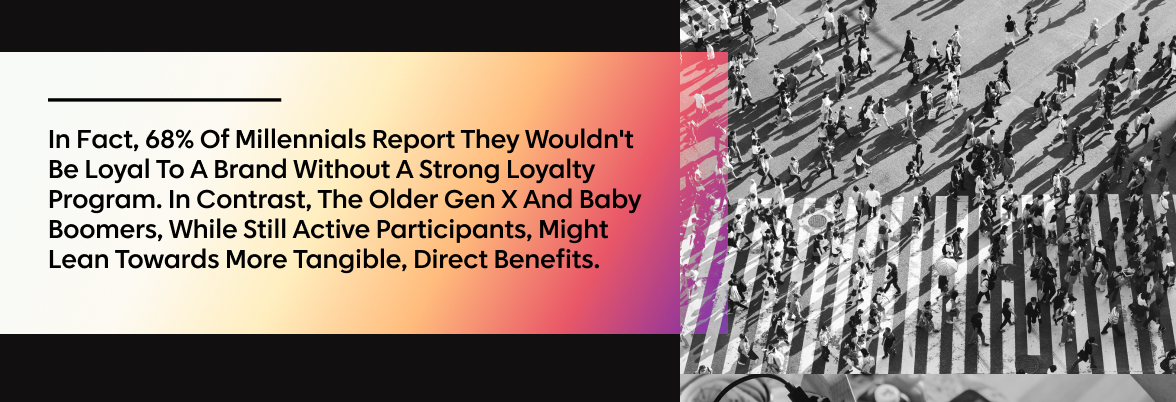From Merchandise to Memberships
The Significance of Loyalty Programs in the Retail Industry

In the dynamic world of retail, the winds of change are ever-present, constantly reshaping the landscape. Among these changes, one strategy has prominently anchored itself in the heart of retailers worldwide: customer loyalty programs. More than just a mechanism for retention, these programs have become pivotal revenue enhancers in an arena marked by intense competition and rapidly evolving consumer behaviors. In fact, 73% of consumers claim loyalty programs should be a way for brands to show loyalty to customers. Imagine walking into a store or browsing an online platform, and feeling an instant connection, a sense of belonging. That's the magic of loyalty programs. They are not just about points or discounts; they are the bridge fostering a two-way relationship between retailers and their customers.
A Glimpse into Current Participation Metrics
As dawn breaks, millions across the globe begin their shopping journeys, both online and offline. In this vast sea of transactions, loyalty programs act as lighthouses, guiding consumers with the promise of rewards and personalized experiences. Recent years have witnessed a surge in the participation of these programs, with consumers eagerly aligning with brands that resonate with their values and offer tangible returns. Reports from 2021 indicate a global rise in loyalty memberships, with 77% of consumers participating in a retail loyalty program. Such trends aren't confined to one region. From the bustling streets of New York to the busy lanes of European and Asian markets, the story is the same.
The digital age has added another layer to this narrative. With technology deeply integrated into our lives, consumers now seek loyalty programs that effortlessly merge with their tech-savvy lifestyles. A recent study indicated a whopping 95% of program members eager to engage via emerging tech platforms. But what drives this engagement? At its core, it's the allure of value and rewards. The modern consumer is discerning, making choices not just based on product quality but also the additional benefits they receive.
However, the loyalty landscape isn't uniform. Dive deeper, and one can spot variations across age demographics. The younger Gen Z and Millennials, with their digital-first approach, show a higher inclination towards tech-integrated rewards.

The Transformative Impact of Tiered Incentive Programs
As we gaze into the crystal ball, the future of loyalty programs shines bright. Propelled by the twin engines of technological innovation and personalized marketing, the world of loyalty programs is on an upward trajectory. The numbers speak for themselves. From being valued at USD 2.5 billion in 2020, the global loyalty management market is projected to touch a staggering USD 10.02 billion by 2027. The recent health crisis has added another dimension to this growth. With an increased focus on health and wellness, tomorrow's loyalty programs might reward not just purchases but also healthy lifestyle choices.

The Art and Science of Loyalty Program Strategies
In the competitive arena of retail, loyalty programs are the MVPs (Most Valuable Players). Just as top athletes must continually adapt and refine their skills to meet the challenges of the game, so too must loyalty programs adjust to the changing preferences of consumers. Enter the world of personalized marketing strategies. Today's consumer seeks a personal touch, a feeling that the brand truly understands their needs. Brands that master this art, leveraging data analytics to tailor offers, are the ones that stand out.
But personalization is just one piece of the puzzle. Gamification, with its blend of fun and rewards, has emerged as a potent tool to enhance engagement. Brands like Starbucks have brilliantly incorporated this, turning the simple act of buying coffee into a rewarding game. Add to this the allure of tiered programs, partnerships, and the seamless integration of technology, and you have a recipe for loyalty program success.
However, it's not just about accumulating points. In the heart of the consumer lies a desire for unique, memorable experiences. Brands that recognize this, offering experiential rewards, forge a deeper emotional connection with their customers.
Mastering the Art of Customer Loyalty: A Holistic Approach
As the retail landscape continues to transform, three pillars are crucial for customer loyalty:
The balance between emotional connections and repeat purchases
The allure of paid enrollments with exclusive perks
The seamless integration of online and offline experiences augmented by cutting-edge technologies.

The Dual Power of Attitudinal and Transactional Loyalty
To stand out in a saturated market of loyalty programs, retailers must focus on attitudinal loyalty, not just transactional, to foster deeper customer relationships and drive sales. While transactional loyalty, such as repeat purchases and buying frequency, can be easily disrupted, attitudinal loyalty, which encompasses brand trust, recommendations, and positive brand feelings, offers a more resilient customer relationship. Brands should regularly measure both transactional and attitudinal metrics to ensure alignment with customer needs and brand loyalty. Additionally, combining experiential benefits with transactional rewards can reinforce attitudinal loyalty and increase customer engagement between purchases. Experiential rewards, such as early access to new products or priority service, can provide unique experiences that enhance customer satisfaction and loyalty.
The Rise of Paid Enrollments and Exclusive Perks
Subscription-based services have revolutionized consumer culture, with retail and service providers adopting this model to broaden their audience and secure a consistent revenue stream. This shift has given rise to paid enrollments in loyalty programs, offering subscribers exclusive benefits such as discounts, members-only offers, and time-sensitive deals in exchange for a fee. This approach leverages the appeal of subscription services and the fear of missing out (FOMO), creating a compelling value proposition.
When integrating paid enrollments, the goal is to provide additional value for those who seek it without complicating the experience for others. A paid enrollment offers an extra lane for customers desiring perks like faster service or exclusive deals, without disrupting the journey for other customers. It's not about pushing a program, but rather presenting a no-pressure opportunity for customers to engage more deeply if they choose. In a world where subscriptions are increasingly common, a straightforward, value-driven paid enrollment can be an attractive option for customers.
Embracing the Digital Transformation
The digital era has revolutionized retail loyalty programs, transforming them from traditional point-based systems to multifaceted platforms that offer personalized experiences, exclusive online events, and more. With global e-commerce sales projected to reach $6.3 trillion by 2024, retailers must adapt to the digital shift by integrating online and offline retail experiences and leveraging technologies like Augmented Reality (AR) and Virtual Reality (VR) to provide immersive shopping experiences. Loyalty programs must now encompass online reviews, social media engagement, and in-store interactions, rewarding customers for the varied interactions with their favorite brands.
Omnichannel loyalty programs, which seamlessly integrate in-store, online, and app-based interactions, have become paramount in meeting the digitally enhanced expectations of consumers. As consumers develop expectations for seamless rewards and benefits across shopping platforms, loyalty programs must provide a unified, frictionless experience. Integrating technology is key to ensuring consistency across platforms, with 77% of consumers preferring to use mobile apps for loyalty-related activities.
Personalization and exclusivity are also crucial, with 91% of consumers more likely to shop with brands that provide relevant offers and recommendations. As the retail sector continues to evolve, retailers must reinvent their loyalty programs to offer value, exclusivity, and a seamless shopping experience across all platforms, ensuring they retain existing customers and attract new ones.

Conclusion: The Critical Role of Loyalty Programs in Modern Retail
Loyalty programs have become a cornerstone in the retail industry. Their evolution from basic point systems to advanced, technology-driven platforms speaks to their importance in today's market. They aren't just about offering discounts or rewards; they're tools that help brands understand, engage with, and retain customers.
The integration of advanced technologies, from AI-driven insights to augmented reality experiences, underscores the industry's commitment to innovation. But technology, while pivotal, is just one facet. At the heart of these programs lies a profound understanding of human behavior and desire. Consumers today seek authentic connections, not just transactions.
As the retail landscape continues to morph, it's imperative for brands to remain agile, adaptive, and consumer-centric. The future promises an even more integrated and immersive retail experience, where loyalty programs will play a central role in bridging the gap between brands and their consumers.
Thank you for your interest in our paper. Happy reading!